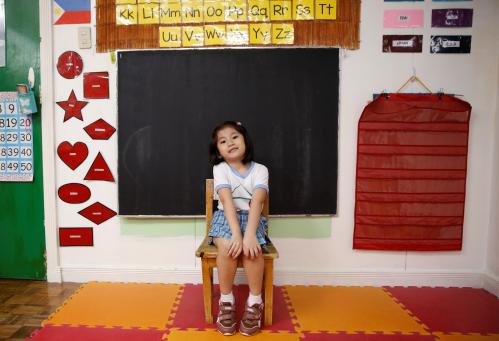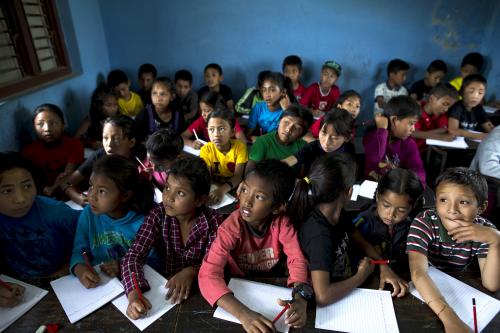In previous blogs, we have talked about efforts to use school-level data to hold providers and governments accountable for delivering high-quality learning for all children. Our research suggests that the success of information-based initiatives depends on the incentives and capacities of both government and civil society. This includes the incentives for government to release high-quality data as well as the capacity and will to respond to demands for reforms. It also includes the willingness and ability of parents and community stakeholders to hold officials to account. Focusing on only one side of the coin undermines the potential of such initiatives to influence education systems.
The Philippines provides a good case in point, which we outline in a new report. The country has made considerable gains in education outcomes. Reforms have decreased the number of out-of-school children, reduced gaps in enrollment between the rich and the poor, and mitigated shortages of teachers, classrooms, and learning materials. For instance, in 2008 only 47 percent of children in the poorest families attended preschool compared with 82 percent of children in upper-middle-income families; by 2013, the size of this difference had shrunk to 5 percent. The government has, at the same time, invested heavily in developing a robust education information management system that captures granular, school-level data on inputs (e.g., teachers, classrooms, water supply), outputs (e.g., student assessments, pass/fail rates), and financing, which has made benchmarking possible.
The Philippines government has recently reinforced efforts at the school level in its attempt to combat lasting hurdles in the education system—high dropout rates, weak student performance, and low teacher quality. A recent World Bank study found that the average teacher could correctly answer fewer than half of the questions on subject matter tests. This low quality education partially explains persistently high dropout rates, which have improved by less than 1 percentage point a year.
The idea is that schools, underpinned by a strong data system, are well placed to identify and improve education quality and student learning. In recognition, the government has created a School Effectiveness Division within the Department of Education, tasked with the implementation of Enhanced School Improvement Planning (E-SIP) and School Report Card (SRC) processes. While SIPs and SRCs have existed since 2001 in the Philippines, the most recent “enhancement” seeks to harmonize school planning with accountability and performance incentive programs while bolstering school autonomy and decisionmaking power.
Government reforms are also complemented by a strong civil society primed to enhance monitoring and accountability efforts, including Check My School, a participatory monitoring initiative introduced in 2011 by the Affiliated Network for Social Accountability in East Asia and the Pacific. This initiative enhances similar efforts by the government to make school-level information available to parents and communities on “transparency boards” placed in schools.
Despite ample data on numerous indicators, however, little of what is available appears to inform decisionmaking; enrollment and out-of-school children figures remain the two most important indicators used for planning and resource allocation decisions. This is because, even with such a strong foundation of data, the country faces political, financial, and organizational barriers to effective data use.
- Political challenges include frequent leadership changes at national, division, and school levels that introduce new standards for success, suspend the implementation of ongoing projects, and perpetuate an incentive system based on political connections rather than merit. Reformers often adopt a “wait-and-see” attitude to survive. Also, resistance from officials at the division and regional levels interrupts ongoing reform efforts despite support from teachers and the central office.
- In terms of financing, funding from both national and local governments is often inadequate, unreliable, and not clearly aligned with need. For example, in some areas schools are given the same amount of funding regardless of their size, whereas in other areas funding is pro-rated based on enrollment. In other cases, school performance is taken into consideration. And even when funds are made available from the central office, discretion by schools is hindered by a misaligned budget schedule and the retention of funds by division offices (e.g., in 2013 only about three-quarters of funds were actually downloaded to the school).
- Last, inadequate decentralization processes have left the bulk of planning and funding decisions at the central level, even though school-based management policies have been in place for over a decade. “Decentralization,” in this sense, is an administrative process involving little or no real transfer of authority to lower levels of government or communities. For instance, parents are only able to influence the lowest hanging fruit with limited impact on core learning challenges. This mirrors data sharing processes; despite the extensive collection of data, the bulk are shared upward and not disseminated to schools for use.
The result is that data are not used to their full potential. Data quality is commendable, collection and management processes are extensive, and policy documents at the highest levels detail the value of data. Yet, barriers to effective data use persist. Misaligned incentives, ineffective communication, and lack of discretion at the school level prevent data from improving education service delivery and advancing student learning.







Commentary
Lessons in using data to improve education: The Philippines
March 8, 2017